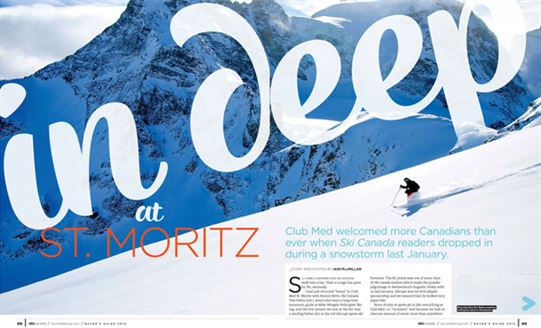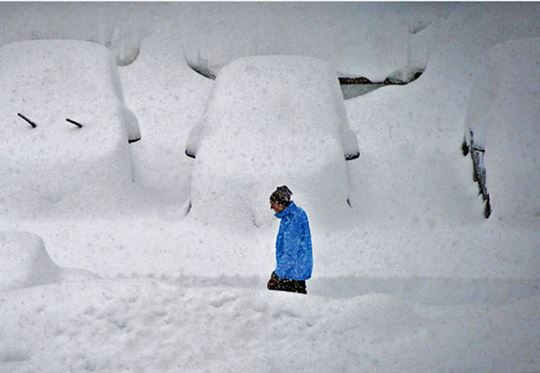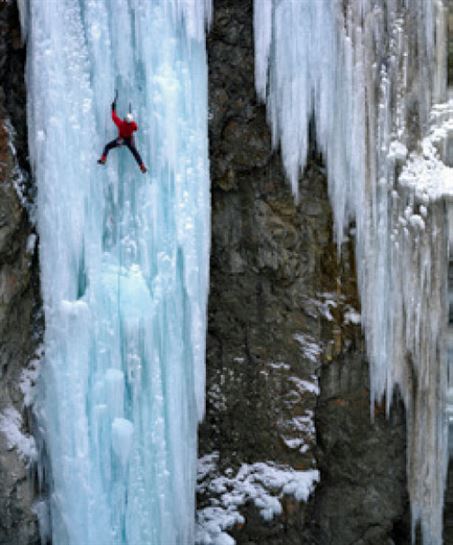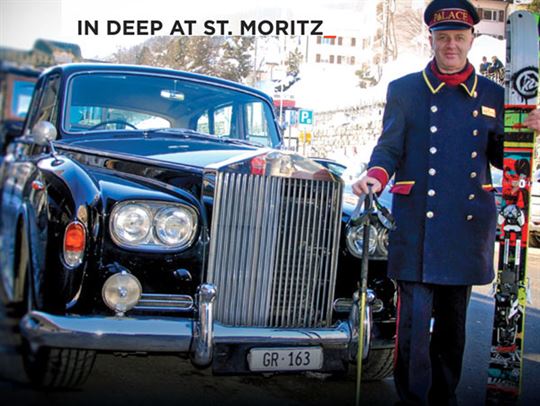So, a priest, a mountain guide and an editor walk into a bar. Then a conga line goes by. No, seriously.
I had just returned “home” to Club Med St. Moritz with Ronnie Betts, Ski Canada Test Editor (ret.), who’s also been a long-time mountain guide at Mike Wiegele Helicopter Skiing, and the first person we saw at the bar was a smiling Father Jim in his red Glerups après-ski footwear. The RC priest was one of more than 50 Ski Canada readers who’d made the powder pilgrimage to Switzerland’s Engadin Valley with us last January. Glerups was his first slipper sponsorship and we assured him he looked very papal-like.
Since drinks at après ski is like everything at Club Med, i.e. “included,” and because we had an obscene amount of snow, more than anywhere else in the Alps, the party had started early; hence, said conga line of cheery Euros merrily weaving its way through the bar—and making it difficult for me to hover about the oyster table.
To tell you the truth, I was a bit apprehensive at the thought of an “all-inclusive” ski holiday. Would this turbo level of group mentality to skiing, eating and drinking work for our lot who’d come from all over Canada? Would we mix well with the international crowd within Club Med, or might it all be too much? For a brief moment I noticed Scott from Cape Breton, also in his cozy woollen Glerups (and next page in furs), join the human caterpillar directly behind a big Sgt-Schultz-like German. Okay, so it was only a momentary sight-gag for a photo, but it appeared our group was up to any challenge that Club Fed, er, Club Med could offer.
Our departure from a typically Swiss family-run hotel for the annual Ski Switzerland with Ski Canada Readers’ Trip couldn’t have been bolder. For North Americans, the concept is almost hard to comprehend. Included in all Club Med ski holidays are three gourmet buffets each day that physically begin before one even enters a dining room (I found just the après-ski spread bigger than a supper at home for me), plonk at dinner, drinks at the bar and nightclub all day and night, a week-long lift pass, lessons or guiding for five days, plus a nightly Club Med staff stage frolic and accommodations that, although hardly posh at the St. Moritz property, were more than adequate given how little waking time was typically spent in the bedroom.
What I wasn’t expecting to hear from others, or experience myself, was our surprisingly favourite part of the Club Med holiday: the group lessons. In my “must experience a little of everything” curiosity, Ron and I casually signed up to join a group of 10 or 12 for the week, anticipating that we’d bail after the first day so we could explore on our own. But plans quickly changed and we quite happily stayed together for our whole week.
Bernie Rietzler is the classic Euro ski instructor, smiling, tanned, both boyish and ruggedly good-looking, a man who women want and men want to emulate. Transplanted from the imperial city of Kempten in Bavaria, Bernie’s excellent English came from teaching several years at Deer Valley (plus he’s German, and many Germans have better English grammar than Canadians). Although some Club Med ski destinations have their own staff ski instructors, in Switzerland they’re subcontracted to established ski schools and Bernie’s “Red Legends” are part of the country’s oldest and largest Schweizer Skischule or Ski School St. Moritz, est. 1929.
After our clutch of six Canadians and three Germans, who had chosen an off-piste group, skied together a few minutes the first day, Bernie asked how much instruction we wanted vs. guiding and we were all quickly in agreement that we wanted only the latter. Within a few runs, we had the camaraderie of a B.C. cat-ski group, with poor Christina—one of the three Germans, soon to be bestowed honorary Canadian citizenship, and the only female—having to translate bad guy jokes as well as endure us.
But more important, we also had B.C. cat-ski conditions. While 2014’s polar vortex was giving the rest of the Alps one of its warmest and driest winters on record, St. Moritz, with its average 320 days of sunshine a year, was getting pounded by snowstorms arriving from the Adriatic. Our daily powder additions over the week was boot-top at worst, thigh-deep at best, and although some Ontario skiers at Club Med found the introduction to powder skiing a bit overwhelming, those who like to go deep couldn’t believe the heli-ski conditions found seemingly everywhere, including directly beneath the lifts. In an area where the local tourist board has been known to offer sun guarantees, I was ecstatic at how we could farm fresh tracks lap after lap all week as different upper-alpine areas would delay opening for avalanche control, and night after night a fresh blanket was laid down.
Simply put, St. Moritz is dominated by visitors in furs, not freeriders, so when it’s snowing, the outdoor lounge chairs and massive sundecks are as empty as the 350 km of groomed runs and wide open bowls that fill up the trail maps. No lift lines, no elbows out waiting for patrol to open runs.
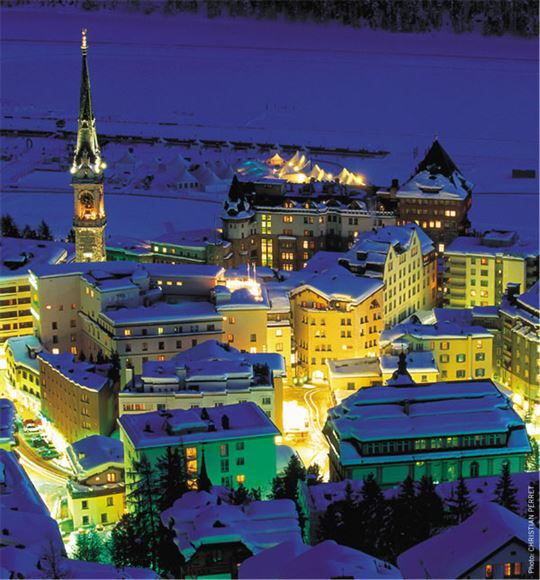
Skiing St. Moritz is at three distinct mountain areas with romantic-sounding names in the once ubiquitous local language Romansch: Corviglia, Corvatsch and Diavolezza. Above the mountainside town are the slopes of Corviglia/Celerina, easily accessed by cable car from St. Moritz Bad (where Club Med lies in the valley), or via alpine cog railway, where the mountainside town of St. Moritz Dorf sits. Dorf and Bad sit apart by a 25-minute walk around or across the lake, or a five-minute shuttle bus ride. Martin Oester at Engadin St. Moritz Tourism generously invited the entire Ski Canada pod for drinks and canapés at a lovely get-to-know-you après ski at the Crystal Hotel in Dorf, where later some in the group took a night off from Club Med’s “all inclusive” to enjoy dinner and an evening out in town.
The second biggest ski area, Corvatsch, is a free Swiss-twisty shuttle bus ride to the main cable cars, but an end-of-day ski home for those staying in St. Mortiz Bad. Both Corvatsch and Corviglia have Club Med mid-mountain lunch restaurants, where a tightly timed and delicious, if boisterous, buffet awaits every day. But for truly spectacular food, views and service at, say, Reto Mathis, the choices are both many and legendary.
The farthest shuttle ride leaves you at the massive alpine circus of Diavolezza-Lagalb, at the Bernina Pass towards Italy. Two cable cars and a couple of chairlifts—in a domain the size of Whistler Blackcomb’s alpine. The area has a week of off-piste opportunities all on its own, many of which can be skied with a ski instructor and group from Club Med. To go farther, hiring a mountain guide from the delightful mountain town of Pontresina nearby will ensure a day of ski adventures you couldn’t possibly find in North America. Plus, your mountain guide will know the train schedule to time your après-ski beer, and whether it’s possible to order the first one in Italian and the second in Swiss-German.
There are strict rules in Switzerland about where in the off-piste Bernie, an instructor not a mountain guide, could take us (as opposed to more relaxed rules at French and Italian Club Meds). That said, Bernie was able to find us more untracked deep powder in our five days than we could have found in five weeks on our own. This single benefit of instruction or guiding that’s included in all Club Med ski holidays could sway any naysayer of cruise ship conga lines.
On our one bluebird day at Diavolezza, Bernie had planned to take us on a 10-km run down the Morteratsch Glacier, however avalanche conditions kept it closed that day. No worries, he found us plenty of untracked and our own private glacier (and some challenging steeps) that left us with huge smiles on our exhausted faces at the end of a long day. If we’d hired a mountain guide, on the other hand, the routes at Diavolezza-Lagalb seemed endless. We had to leave some, like the classic Tour La Rösa, for a return trip to the Engadin.
I remember the immaculate grooming, even into the farthest reaches of the resort, from my last visit to St. Moritz about 15 years ago. But on this trip there was more than a metaphorical army of cat drivers on their PistenBullys making corduroy; Corviglia had the Swiss army onslope and they were seemingly all concentrating on one project. With 2014’s winter of weird weather, balmy January temperatures in Garmisch cancelled its World Cup downhill and the White Circus had moved to Corviglia. Battling the stormy powder gods all week, teams of 24-hour workers drilled enormous holes into the piste every couple of metres and injected it with freezing water to harden the course into white pavement.
Saturday, our last ski day, and so much was still not personally skied, not seen, not eaten. Ski Canada trip veteran James and I split from the group, most of whom wanted to get up Corviglia early on race day to bagsie the best viewing spot above the layers of crash fencing. James and I headed the opposite direction to Corvatsch, hoping if we hustled we could get in some crazy powder lines and still catch the earliest bibs down the course by skiing back to the St. Moritz Bad cable car to take us to Corviglia and the race.
The plan worked wonderfully; we made it to the start, or at least the highest spectators can get to the start given the start hut appeared to be at the top of an elevator shaft. After the third forerunner whistled past James and me, a short delay was followed by a sea of athletes and coaches—bailing. Poof! More than a million francs and countless hours of prep work were gone to the laughing powder gods who’d “spoiled” the day. From not enough snow to too much.
While I was star-struck with the world’s best in skiing now filing past with enormous backpacks of gear, I realized six-foot-two James was shuffling past an official’s hole in the fencing and was now “on course.” I followed about 20 seconds behind.
We were only stopped by officials three times on our downhill run (with several divergent turns into thigh-deep powder stashes that had been left untouched all week), but it was our knapsacks and fat skis that confused the crowds still milling about the finish area at the bottom when we skidded to a stop and tossed a ski above our heads to the imaginary cameras. Only in St. Moritz.
Too much powder?
There are likely more distractions in St. Moritz and the Engadin Valley than at any other resort in the world.
- Sledge the Schlittelbahn at Muottas Muragl, St. Moritz’s fourth alpine resort.
- Lifts, only CHF35 (about C$40) a day if you’re staying at most hotels, start boarding at 7:45 but you can also ski under a full moon every month.
- Stay longer in an apartment: C$600 per person per week in a 3-star, including ski pass.
- Soak in Europe’s highest hot tub atop Diavolezza.
- Ride a bobsleigh—helmet and cocktail (afterward) included.
- Learn to kitesurf at Silvaplana.
- Hike 150 km of winter trails with woollen-seated cafés and huts along the signed routes.
- Curl, skate or play hockey in virtually every town in the Engadin.
- Watch a World Cup race (St. Moritz is home to two Olympics and 20 World Championships).
- Pose at a polo match (or horse race or cricket match or gourmet festival or symphony or…).
- And my personal favourite? Ice-climbing in perfect little Pontresina nearby. The mountain guides at Bergsteiger Schule will find you some long and lovely (and safe) powdery routes to ski during the day that you’d never find on your own—and if you’re up for it, take you ice-climbing at après ski. Beginners to experts climb some spectacular canyon icefalls created right in town for the annual Open Swiss Ice Climbing Festival (which you’re welcome to watch if you prefer your ice in a drink). Bergsteiger-pontresina.ch
How do you say…
Why do we pronounce St. Moritz in a French accent? Who knows! The Engadin Valley is as far away from French Switzerland and France as possible. Given everyone speaks Swiss-German, shouldn’t we at least be saying it like the locals do: “Sankt Moritz”?
The first mention of St. Moritz appeared in the ’30s—that would be the 1130s (ad sanctum maurician, as the tourist websites were in Latin in those days). But Bronze Age sightseers left trinkets about the mineral springs (St. Moritz Bad) long before the Romans arrived in their bathing togas. Five hundred years ago, Pope Leo X offered full absolution to anyone who made the pilgrimage to the Church of the Springs. (Leo X wasn’t the skiing pope; that was Jean-Paul II.)
Even before Upper and Lower Canada hooked up with the Maritimes, in fact, 150 years ago this year, local hotelier Johannes Badrutt proposed to some British summer guests a “winter holiday,” even offering to pay their return transportation if this novel idea wasn’t to their liking. Soaking up the winter sun all day on their south-facing balconies above the lake in southern Switzerland’s champagne climate was enough to keep them put—and then return with friends, and friends of friends, in the years that followed. There’s been no looking back.
Today, the truly majestic Badrutt’s Palace (the grand-daddy of six 5-star hotels at St. Mortiz) has more than 500 employees doting on guests who return decade after decade, some who never actually ski: old Euro money, dressing for dinner, seemingly oblivious to the artwork worthy of hanging in any European gallery, cocktailing in the nightclub like James Bond would.
All guests are collected from the railway station in one of three Rolls-Royce limos, each with its own story. (The Palace bought the one above second-hand—from H.M. Queen Elizabeth II.) Not surprisingly, the guest book is a who’s who from past and present Hollywood to crowned heads of state to sports stars.
Living at Badrutt’s for a month or two might tip the average Ski Canada reader’s budget, but there were some surprisingly affordable two- and three-day getaways available online, including lift passes and breakfast among the palms and harp playing in the grand dining room. Needless to say, the splurge will be remembered long after the bill is paid.
